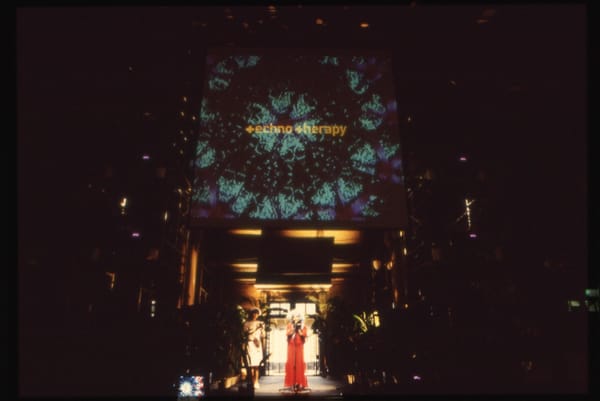Ideas
Mobile M+: Moving Images (Part Five: Paris, Texas)


The four-part thematic screening program “Mobile M+: Moving Images” came to a close on April 19 with the 1984 film Paris, Texas. Following themes of “Hong Kong,” “Hope” and “Dreams,” M+ moving images curator Yung Ma’s exploration of migratory cinema took viewers full circle, ending with the motif of “Home.”
Paris, Texas is a drama about that loss, reconciliation and sacrifice that entails the search for that thing we call "home." Directed by German filmmaker, author, playwright and photographer Wim Wenders, the film first premiered at the 1984 Cannes Film Festival, where it earned top awards from all three members of the jury, including the Golden Palm prize. Paris, Texas was later screened at the Sundance Film Festival in 1985 and has since become a much revered cult classic.
Stretching over two hours, Paris, Texas centers on the life of a man who, at first, seems to have appeared out of thin air, and whose deeply saddening past is divulged over the course of the film. Set in 1980s south Texas, the disheveled and scruffy protagonist, Travis, is seen wandering aimlessly around the vast desert. Travis collapses at the doorstep of a saloon only to be encountered by a doctor who, after treating him, calls a number he discovers in the lost man’s back pocket. The dialed number leads to Travis’s estranged brother, Walt, who agrees to pick him up.
What follows is a journey of reconciliation. Firstly, between the two brothers as they travel from Texas to Los Angeles, and subsequently between Travis and his son, Hunter. The story of Travis' past is slowly revealed to the audience, in bits and pieces. Through Walt's incessant questioning of his silent brother, it is unveiled that Travis had disappeared four years prior, abandoning Hunter, who had since been in the care of Walt and his wife, Anne. Travis finally breaks his silence when he utters the word “Paris” while reading a map. Mistakenly, Walt assumes that Travis is referring to the capital of France. Travis clarifies that he is in fact referring to a desolate Texas town where he owns property, and which he believes is the site of his conception, based on childhood stories from their parents.

Arriving in Los Angeles, Travis reunites with Anne and Hunter, who is now seven years old. At first the boy is hesitant to be around Travis. But over the course of what appears to be several weeks, their relationship warms, as Travis becomes a stable presence in the Hunter’s life and even walks the boy home from school.
Revelations of Travis' past continue with the disclosure of the passionate love story of Travis and his estranged wife, Jane, who also disappeared in a separate incident four years earlier. What happened between the couple and the circumstances that led to her disappearance remains a mystery. Only Travis knows and he isn’t ready to break that silence, much to Walt’s frustration. One night, Anne informs Travis of a bank account under Hunter’s name, into which Jane deposits money on the same day every month. The deposits are made in Houston, Texas, 300 miles south of Paris.
Travis becomes determined to find Jane and Hunter decides to accompany his father to Texas. During the road trip, father and son bond over old family stories and Hunter’s school adventures. It doesn’t take long before they learn of Jane’s whereabouts, and Travis follows her to a striptease club. There, customers are seen using telephones to send instructions to the strippers on display. The strippers are on the other side of a one-way mirror that obscures performers' view of their customers. The following day, Travis returns to the club and encounters Jane, who cannot see him behind the mirror. Travis alters his chair around and with his back to Jane, he begins to tell the story of a couple whose love turned from joyous to stifling, describing how the drunken man, jealous and controlling, suffocated the young girl. He talks of how the man came to resent himself, eventually never wanting to see anyone again and disappearing to a place “without language or streets.” Jane, at first confused, quickly realizes the man on the other side is Travis—and that the story he is telling is theirs. Finally, we fully understand his painful story of love and loss. Just when the viewer imagines a reconciliation, Travis shares his decision—much to Jane's objection—that mother and son, but not husband and wife, should be together.
The film’s concludes with Jane and Hunter’s reunion, and Travis’s solo departure from Houston. To suffer the loss of his family, once again, becomes Travis’s biggest sacrifice for the sake of the happiness of the two people he calls "home."
Paris, Texas forces viewers to consider the consequences of love, family responsibilities and sacrifices. The film is heartfelt and tragic, but if all the emotional drama seems too much, the cinematography alone is sensational—its wide shots that span the desert landscape and offer bird’s eye views of suburban Los Angeles. It was, indeed, a memorable end to “Mobile M+: Moving Images.”
Denise Tsui is assistant editor at ArtAsiaPacific.







